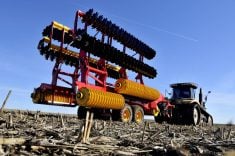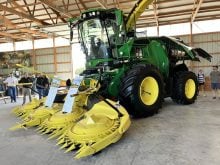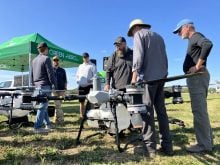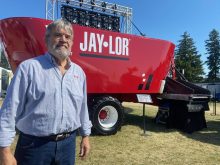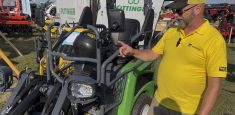The Salford Group has launched a new spinner spreader, called the Sniper, that enables farmers to control sections of spread for increasing accuracy, less overlap and less environmental impact.
The spreader spreads 120 feet.
The challenge designing the spreader was the lower quality and consistency of fertilizer in North America, said Anson Boak, Salford’s marketing manager.
BBI, Salford’s division that designs and markets spreaders, has been working on the Sniper for several years.
“In Europe there are applicators that are spreading the 36 m, 120 ft pattern no problem, but they are relying on a higher quality of fertilizer,” he said, at Canada’s Outdoor Farm Show. “BBI put a lot of time into perfecting Javelin technology specifically to spread urea 120 ft, and making it much more capable of taking in different quality fertilizer.”
Read Also

Defence investments could benefit agriculture
A bump in Canada’s NATO spending commitments could lead to infrastructure investments that would benefit rural areas
Then they worked to make a spreader deck that spreads any type of fertilizer 120 ft, including MAP, DAP and urea.
“We designed this new spreader for farmers who are looking for the most cost-effective and consistent dry fertilizer delivery with a pull-type applicator,” said Richard Hagler, president of Salford’s BBI division. “The Sniper’s patent-pending technology was specifically engineered for and tested in irregular fields to prove it could help protect environmentally sensitive areas and reduce application overlap.”
Just as important as the spreader width, is the section control available on the Sniper. Once left and right split chain systems were developed for larger spreaders, the company could then look to section control.
There are 12 sections total, six for each side that can be turned on and off as needed.
“We are getting as many swath sections, with fewer moving parts,” than other machines, said Boak. “We believe it will be a more reliable, more durable system, simply because it has fewer moving parts.”
There are three main systems than enable the swath control:
- Left/right hopper sections that use Salford BBI’s proven split conveyor for maximum control and rapid adjustment on the fly. Each side of the conveyor feeds its own flow divider and spinner, allowing half-width spreading along field boundaries and sensitive areas.
- A closed, multi-fin flow divider tightly controls the fertilizer’s drop point onto the spinner, ensuring accurate material delivery and providing protection from wind and minimizing the impact of slope.
- Independently controlled spinners engineered to speed up or slow down to accommodate varying swath widths. The system is calibrated for 12 sections, six per side, to maximize compatibility with ISOBUS virtual terminals and allow effective application at widths up to 120 feet in one pass.
In addition, the BBI Sniper features dynamic metering for more precise application rates. The dry rate controller monitors scale readings and tunes the metering system accordingly.
Controlling 12 sections means more IOSBUS flexibility for compatibility with more tractor systems.
“Spreader swath control is a complex job involving multiple systems working together,” said Brad Baker, senior product manager at Salford Group.
The advantages of swath control include the ability to limit overlap, saving fertilizer. It also helps farmers keep extra nutrients out of the environment where they are wasted, by being able to shut off the spread to avoid marked areas.
Farmers are interested in the technology in order to make more efficient use of their fertilizer, especially with the growth in 4Rs concept around precise use of fertilizer.






